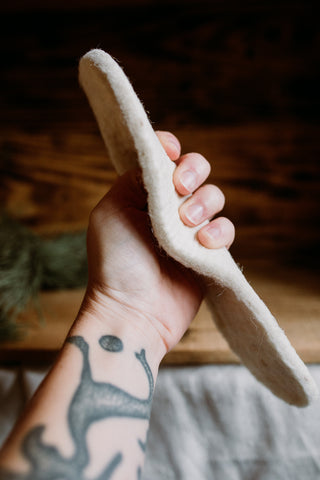Those who want to be able to maintain the barefoot feeling even in the cold season quickly ask themselves two questions: Are minimal shoes warm enough in sub-zero temperatures? And what happens in case of rain, snow, and black ice? Matching the footwear, here are the answers.
Heat is created primarily by movement. If we are standing at the bus stop with thick woolen socks and conventional, lined boots with a thick sole, we can still have freezing feet, but: Even in unlined Wildling shoes, hardly anyone who is jogging is freezing. Exercise promotes the blood circulation of our feet and thus keeps them warm. For the foot to move, it is important that it has enough space, despite thick socks and insoles. So, you may need a shoe size larger than usual in winter. Tip: To measure the feet, put them on the Fitkit in thick wool socks, if you want to wear the shoes with these socks later.

Image: Sandra Dienemann
With Wildling shoes through winter
For colder days, there are models made with wool in the Wildling Shoes repertoire – as wool stores body heat like no other material and thus keeps the feet warm. With its breathable, temperature-balancing and naturally cozy properties, it offers the best conditions for use in winter Wildling shoes.What if you prefer not to wear wool or are allergic to it? Then there is (and fortunately more and more of it) the plastic-free, warming lining made of hemp-flax fleece. If the lining seems a little stiff at first, you can quickly soften it by kneading it or wearing it a few times.
Tip: If you select "Autumn / Winter" in the shop and set the sustainability filter to "Vegan", all warming models with hemp fiber lining will be displayed.
Insoles for added warmth
Beyond that, an additional insole can also provide protection from the cold – fluffy soft Woolys, Feltys or the vegan, not quite as thick variant Hempling. Wildling Shoes offers insoles made of wool as well as the vegan alternative made of hemp.

The natural materials virgin wool and hemp-flax fleece have both moisture and temperature regulating properties, creating comfortable wearing conditions. To avoid waterlogging, the insoles should be removed from the shoes to air them after wearing. Particularly practical: Especially for narrow feet or an intermediate size, insoles can help to reduce a shoe's volume, so that it can adapt to the foot even better.
Insoles overview
Hanfling
- Vegan
- Has an insulating, temperature-regulating, and moisture-absorbing effect
- Wearable all year
- Suitable especially for warm footed people
- Their waterproof, black bottom keeps moisture out
- Its thickness of 4 mm makes it especially suitable for narrow feet to reduce the shoe's volume a little
Wooly
- Made of high-quality felted wool loden (from Pomeranian sheep) and is therefore sturdy retaining its shape
- Rather flat: The barefoot feeling is particularly noticeable
- Thin natural latex rubber coating on the bottom, making it more slip resistant
- Also great for the transitional period
- Note: Due to the origin and production in Germany, Wooly saves CO2, which means it has a smaller ecological footprint than Felty
Felty
- Wool from the Austrian Mountain Sheep
- The warmest Wildling Shoes insole
- Just like Wooly, it has a thin natural latex rubber coating on the bottom, making it more slip resistant
- Note: Felty are thicker, providing more warmth than Wooly, but get a little thinner over time
Wildling shoes in slippery and rainy weather
If one gets surprised by a short downpour on the way to work or at the playground, Wildling shoes usually don't mind. It is important that they are prepared a little and maintained regularly, depending on materials, and intended use. You can read about how to properly waterproof your Wildling shoes and dry them in the Help Center or watch our how-to videos.
Tip: You can find useful information on care for your Wildling shoes on the product page of the respective model in the shop.
Since Wildling shoes do not have a tread, it could get a little slippery in the cold season. However: Even with conventional shoes, the risk of slipping on compressed snow and ice should not be underestimated. So regardless of which type of shoes you wear, the main precaution in icy conditions is a mindful gait. Consciously perceive the ground (which works especially well wearing shoes with thin soles) and avoid sudden, quick movements. Great tips and tricks for these topics and many more are always shared in the Wildling Community auf Facebook, feel free to drop by!
Cover image: Sandra Dienemann



